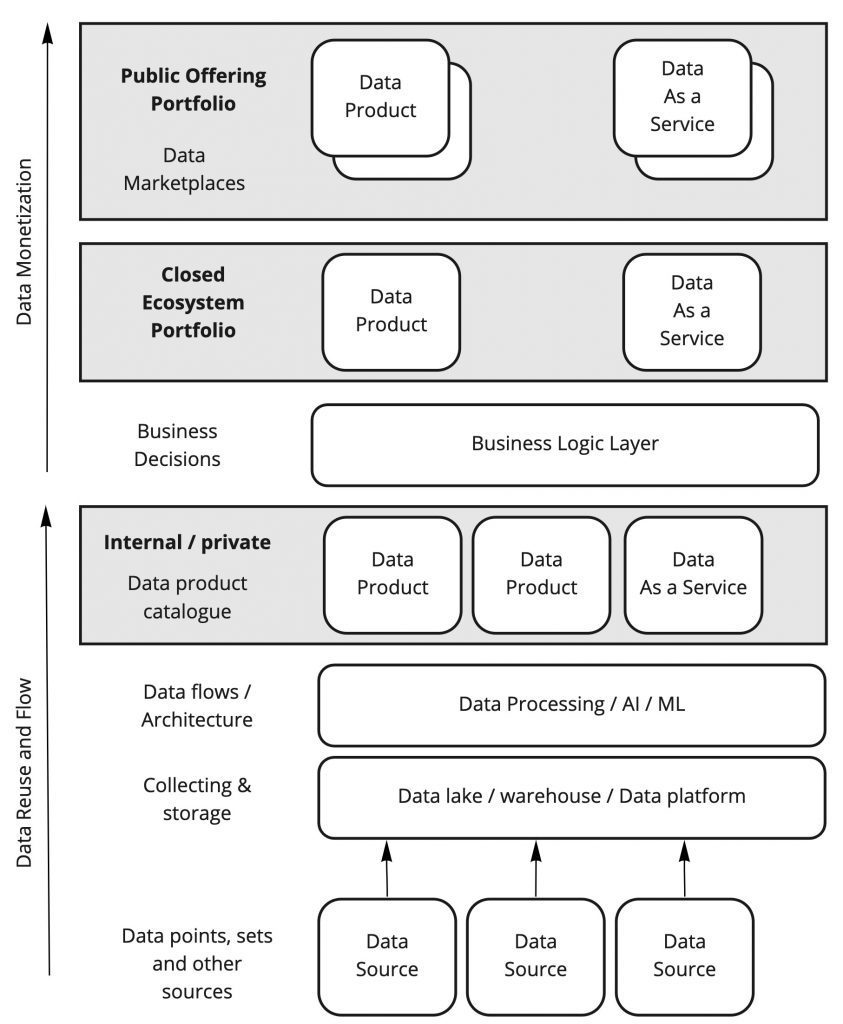How can organizations utilize their data and design data products to maximize internal reuse and partner network value? Eventually, how can organizations monetize derived data-driven services?
We had an opportunity to find out the answers to these, and many other questions through the interview with Jarkko Moilanen, PhD. Chief Data Officer of Vastuu Group Oy, who is also a speaker at the 7th edition of the Data Innovation Summit.
In this interview, you can find detailed explanations of the difference between data products and data services, the importance of productizing data in a shorter time, and some advice on how organizations can start with their data monetization strategy.
Hyperight: Can you tell us more about you? What are your professional background and current working focus?
Jarkko Moilanen: I have a key role in managing the portfolio of advanced and innovative data-driven development customer cases, and managing data strategy, as well as data management. Prior to my employment at Vastuu, I served as the Chief Operations Officer and Chief Development Officer at Platform of Trust. For 4 years, I was leading the digitalization in K12 education in Finland, as Senior Advisor on Digital Strategy at the Ministry of Education and Culture of Finland.
I earned my doctorate degree in 2017 at University of Tampere with my work entitled “Peer Production economy – revolution in design, development and manufacturing”. I’m currently pursuing my 2nd PhD in University of Jyväskylä around the design driven data productization process, which binds together data products and data strategy in companies.
I am the creator of Data Product Toolkit, which helps organizations take advantage of data, design data products to maximize internal reuse and partner network value, and eventually monetize derived data driven services. As part of the toolkit development, I have defined first in the world Open Data Product Specification which is a vendor-neutral, open-source machine-readable data product metadata model. It defines the objects and attributes as well as the structure of digital data products.
Hyperight: During the Data Innovation Summit 2022, you will share more on “Data monetization and related data value chain requires both data products and services”. What can the delegates at the event expect from your presentation?
Jarkko Moilanen: Let’s approach the question from a data value chain perspective. In the presentation, the suggested framework of the data monetization landscape contains three publicity layers: 1) private/internal, 2) partner / closed data ecosystem, 3) and public.


Of course, the real world is not this simple and diffusion between the publicity levels occurs. In some cases business goals require operations on all of the layers, occasionally private is enough. During the past couple of years, I’ve been helping in 200+ data monetization cases. In some cases the product-dominant model is better, but more often the service-dominant approach offers better value for all involved parties. This transition from products to data-driven services is a key element of the presentation. The above mentioned model is discussed with practical examples which are derived from real world cases. You can expect to find compact nuggets of facts to use in your organization while progressing forward.
Hyperight: In your presentation, you will speak about productized data and data servitization. Let’s start by explaining these terms, the difference between them and their value to the organizations? Can productized data and data servitization be approached separately, or they are consequential to each other?
Jarkko Moilanen: Data economy is servitized just like any other business. Servitization is the innovation of an organization’s capabilities and processes to shift from selling products to selling integrated products and services that deliver value in use. The principle of monetization can be squeezed into three points. First, productize data for internal use to gain maximum speed. Secondly, productize and servitize data to maximize partner networks (closed data ecosystems). Finally, servitize data to maximize sales and customer value (public level). In the productization source data is refined, cleansed, even analyzed and packaged so that it has a clear value proposition, description, pricing and great customer experience. The needed tacit knowledge to work with the data has been removed and as cherry on top of it is an attractive product name. In data servitization the customer is more deeply involved and value is co-created. Data as such is not sold, but the service built around it is. In other words the data products enable faster data-driven service development and agility to match changing customer needs.
Hyperight: You say, “raw data is worth money, but productized data is worth a million”. How can organizations productize their data?
Jarkko Moilanen: Based on more thorough analysis of market places and academic literature, various types of Data Products and Services can be identified: static data products, data streams, rendered data products, and functional data products. Example of static data products is dataset which is the most common sharing format in open data. The datasets are static and are sometimes updated occasionally. Selling datasets has been there also for a long time. Example of a commercial dataset is company contact information. Different kinds of PDF reports and documents go in the same category. Data streams driven data products are currently offered either via their own API or interface provided by data platform. The API access can be traditional request – response, hook based or in some cases subscription (pub/sub) based. The data platform provided access is quite often SQL-based. Rendered data products offer dynamic, often visualized and formatted views to the data product content. Also, data products which are compatible with various digital twin solutions and game engines, such as Unreal, as well as map service compatible data products, fall into this category. These products often resemble services. Functional data products are APIs and algorithms. Examples are algorithms for data mining, matching, cleansing, relevance computation and lineage tracing. Developers may upload these algorithms to a data marketplace as a black box user-defined-function, so other participants of the data marketplace may ’buy’ and try out these algorithms. The other subcategory is bidirectional data products which are intended to give control commands or alike to the data source system instead of just getting information for application.
As you can see some of the ”products” resemble services more than products in the sense that those are traditionally understood. For example the streaming data product is clearly offered as SaaS – Software as a Service. Thus such data products logically would be called data service, but that seems to confuse some of the people.
Hyperight: Data should be productized in a shorter time to market timespan. Can you tell us why is this important?
Jarkko Moilanen: Every business developer knows that getting to the markets sooner than rivals is crucial. That might be needed in launching a new product or service. It can also be an improvement to an existing solution based on customer request or feedback. Now, turn your eyes on the data-driven service you wish to launch to the markets. Your data-driven solution most likely uses multiple data sources. If your data analysts and data engineers need to build the data pipelines or try to understand what every field of the databases means, you will be too slow and that is also a prime example of resource wasting. Instead you should productize data you have access to. This might be domain driven as Data Mesh suggests. Then, you can build new data-driven solutions on top of the huge easy to use and understand data mass faster than before and hopefully faster than the majority of your rivals.


Hyperight: If productized data maximizes the inside company’s digital premises, then data servitization is when companies reach out, sell the data products and maximize the data monetization. What strategies are available for organizations in their data monetization journey? How can they know when to start this journey?
Jarkko Moilanen: Entering data economy often requires business strategy level changes. Thus it’s not a small decision and the implementation is years long process. Common approach is to define a data strategy which supports the business strategy. Together the strategies become a data monetization strategy. I’m advising companies to start with internal data products first. Get your basics in shape: agile data architecture, business skills and data literacy among the staff. Also build and get familiar with the processes needed to productize data. After you are confident of your performance, knowledge and skills level, then step outside and try data ecosystems. Not all need to go to public level eg. sell data or data-driven services in the data marketplaces. How far you advance in the publicity depends on your business strategy needs.
Hyperight: One of the learning points in your presentation is that the costumes are the ones that drive the value in data servitization. Tell us more about the importance of this approach!
Jarkko Moilanen: An academic article by Stephen Vargo and Robert Lusch from 2004 about new service-dominant logic fuelled a truly international discussion about the potential of service logic to change the mainstream, goods-based logic. Service-dominant logic is a perspective for understanding value creation. Value creation in turn is at the core of practically any business. The goal of service systems is to provide input into the value-creating process of other service systems. All involved parties should gain some value. The firm gains for example financial benefits and customer value in terms of becoming “better off” in some way. In service-dominant logic, the customer is not an object, but an active subject – one source of value creation. The customer is always a co-creator of value and is always involved in the value-creation process. According to some scholars, the customer is the primary creator and evaluator of value. The service provider could be invited to join this process as a co-creator but without the customer, goods or services have no value except negative due to related costs.
The firm is fundamentally a value facilitator. The service approach focuses on interactions instead of exchange. The producer is not so much trying to match the customer’s expectations in advance which is a must-have in product-dominant logic. Instead, the service provider is not restricted to offering value propositions only but also can directly and actively influence customers’ value fulfilment in some situations. Service is more about the process than the result. Instead of luring consumers to the exchange process, the old goods-based, we are geared towards facilitating interaction.
As you can see, with services we are interacting with customers, we are co-creating the value. At the same time, we are more tightly connected with the customer and the relationship is easily deeper and stronger than before. This is often a must have approach in data economy since the customer has the data and you have the skills to work with it for the benefit of the customer. It is just natural to be “merged” at some level to achieve maximum value. The relationship resembles more partnership than traditional provider – customer.
Hyperight: What are your final recommendations for those interested in data monetization? What should they pay attention to?
Jarkko Moilanen: Be bold but take small steps. Learn by doing and tolerate mistakes. The biggest mistake you can make is to let IT lead your data economy journey. That process must be led by the business layer and IT supports it. You need to have a technical layer in shape, manage the data and processes but above all, you must have data economy savvy business developers. If you don’t have the skills, don’t be shy to purchase the Chief Data Officer as a Service and build the talent inside your house under his guidance.
Hyperight: What’s the best advice you’ve received during your career, and what would be your advice for any data enthusiast?
Jarkko Moilanen: Trust the data. Whatever you do, make it data-driven. Stop guessing and trusting your gut. Our reptile brains operate on feelings first, and after that, if you are lucky, with logic.
Use data in support functions to help you in making best possible business decisions. Data must be in the DNA of your company.
Featured image credits: tungnguyen0905 on Pixabay














Add comment